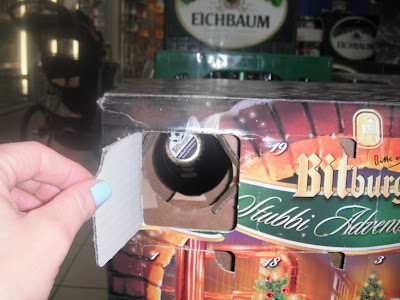Yes, he most certainly does.
As to the first two questions:
Foods. Walking through a German supermarkt (I need not translate that one, I hope), you can quickly see Germans value two food groups: pork... and fruitcake (is that actually a group?). Various regions of Germans put on their own fancies to each of the groups, but ultimately, every table likely has some beautiful slab of salty meat and a Christstollen (fruitcake specific to Christmas).
Here in Southern Germany, the more common pork presentation is a Schäufele, or a corned, smoked ham. The preparation in Franconia is a bit different from other areas: here, they take the pork shoulder meat, cut the bone and rind criss-cross, season it with S&P and caraway, and roast it with veggies and (you guessed it) beer. It's crispy on the outside, tender and juicy on the inside, and full of fabulous porkness (that is a word, right? No? Well it is now). Families serve this dish with either Kartoffelklöße (these goofy potato jelly balls, which we euphemistically think of as the German dumpling) or Kartoffelsalat (potato salad) -- and here, the potato salad is like the perfect blend of yellow and white potato salads you encounter in the States, with a nice tangy bite, a touch of dill, and just enough creaminess to keep it from tasting a little too bitter.
 |
| See? Isn't that a goofy dumpling? |
As for the fruitcake, we failed ever to buy one, but we even saw the Bamberg Commissary on post embracing the Christstollen, with fruitcakes peppering the end of almost every aisle. Instead of our U.S. cakes, which are typically in that contrived tiny rectangular packaging, leaving little room for flavorful bread and instead focusing heavily on unidentifiable jellied candies and old, stale nuts, the spiced loaf of the Christstollen brims with plump raisins, candied fruit, walnuts, and almonds. Even better: The Germans coat these suckers in powdered sugar. Oh, wait, it gets better: Some of the Christstollen are filled with marzipan (a paste consisting of almonds, powdered sugar, and egg).
 |
| Don Christstollen, the godfather of all fruitcakes |
Traditions. This one is a tradition we're tempted to teach to Liam. First, a clarification: Germans recognize not one, and not two, but three important figures during the Advent season. They acknowledge the Weihnachstmann (Father Christmas), who is the chubby, jolly old soul we each picture when we think of the commercial Santa Claus. This guy visits homes on the afternoon of Christmas Eve, but primarily to share the joy of Christmas.
The children receive presents from Nikolaus, who actually does dress a lot like Santa. He wears a long, red cloak, totes a Gandalf-esque white beard, and carries a bishop's staff. Nikolaus is the Germans' interpretation of Nicholas of Myra, the Greek Christian bishop who died on 6 December A.D. 346. During his life, he was believed to make miracles and was suspected of giving children and the needy secret gifts. Now the patron saint of little children, sailors, merchants, and students, St. Nick comes around Germany and either rewards or scolds the children by way of the gifts he leaves for them. On the evening of 5 December, German children take their best pair of boots, and shine one of them to its most brilliant to leave out on the stoop for Nikolaus (only greedy little buggers put out both boots, and they would be wise not to, for fear of getting two boots full of bad gifts). The good German children awaken on 6 December to run out and find candies, little toys, coins, and thoughtful trinkets from Nikolaus. The children who did not behave quite so well may find coal... or even a switch. Yes, Nikolaus has been known to leave a needy parent a little whip to use on a trouble-making bottom. Some parents even enlist a personal appearance, sending Nikolaus to the children's school to inquire them directly about their misbehavior in front of their peers.
This separation of celebrated figures means that, in the traditional German home, Christmas day is about Christ -- talking about his birth, the gift He has given to the world, and the love He has provided each child who can then share it with the world throughout the year.
Pretty nice tradition.
Reflecting on the Advent season, I can't help but share these additional tidbits with you.
This is how Germany rocks Advent calendars:
 |
| The Adult Edition |
 |
| Yes, that is a BEER |
 |
| The Kids' Edition (given to us for free from the people at OBI - the Deutschland Home Depot. Text says, essentially, "We wish you a bright festival") |
 |
| Don't worry, it's solid chocolate for the bairns |
On our ride back from Edelweiss, we also got a chance to see how the Benz dealer in Munich displays the Advent calendar. It took us until we got home and saw the video to realize it, but watch closely and you'll see the windows display a different car for each day (with a few yet to be filled, being it was not yet Christmas... I wonder what models we missed?):
And this is how Liam enjoyed his Advent season, nativity set-style:
Liam must have heard about the wicked sandstorms they get in Bethlehem.
Oh, oh! then that sweet smile! :-) The fruitcake looks great! I wonder if I could just sprinkle some powdered sugar on mine from the route - maybe add a few almonds on top.. couldn't hurt! Thanks again for sharing, making us feel like we are there with you guys! love, mom
ReplyDelete